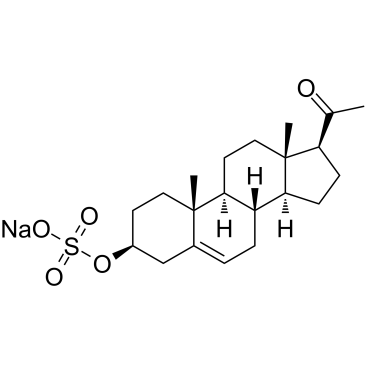Pregnenolone sulfate sodium salt
Modify Date: 2025-08-25 20:51:01

Pregnenolone sulfate sodium salt structure
|
Common Name | Pregnenolone sulfate sodium salt | ||
|---|---|---|---|---|
| CAS Number | 1852-38-6 | Molecular Weight | 418.52300 | |
| Density | N/A | Boiling Point | N/A | |
| Molecular Formula | C21H31NaO5S | Melting Point | 192ºC(lit.) | |
| MSDS | Chinese USA | Flash Point | N/A | |
Use of Pregnenolone sulfate sodium saltPregnenolone monosulfate sodium salt (3β-Hydroxy-5-pregnen-20-one monosulfate sodium salt) is a powerful neurosteroid, the main precursor of various steroid hormones including steroid ketones. Pregnenolone monosulfate sodium salt acts as a signaling-specific inhibitor of cannabinoid CB1 receptor, inhibits the effects of tetrahydrocannabinol (THC) that are mediated by the CB1 receptors. Pregnenolone monosulfate sodium salt can protect the brain from cannabis intoxication[1][2]. |
| Name | sodium,(17-acetyl-10,13-dimethyl-2,3,4,7,8,9,11,12,14,15,16,17-dodecahydro-1H-cyclopenta[a]phenanthren-3-yl) sulfate |
|---|---|
| Synonym | More Synonyms |
| Description | Pregnenolone monosulfate sodium salt (3β-Hydroxy-5-pregnen-20-one monosulfate sodium salt) is a powerful neurosteroid, the main precursor of various steroid hormones including steroid ketones. Pregnenolone monosulfate sodium salt acts as a signaling-specific inhibitor of cannabinoid CB1 receptor, inhibits the effects of tetrahydrocannabinol (THC) that are mediated by the CB1 receptors. Pregnenolone monosulfate sodium salt can protect the brain from cannabis intoxication[1][2]. |
|---|---|
| Related Catalog | |
| Target |
CB1 Human Endogenous Metabolite |
| In Vitro | CB1 receptor stimulation increases brain Pregnenolone levels, which in turn exerts a negative feedback on the activity of the CB1 receptor antagonizing most of the known behavioral and somatic effects of THC. Pregnenolone likely acts as a signaling-specific negative allosteric modulator binding to a site distinct from that occupied by orthosteric ligands. Pregnenolone does not modify agonist binding but only agonist efficacy[1]. The effect of THC is significantly attenuated when slices are pre-treated with Pregnenolone 100 nM (15.1±1.8 % of inhibition). These effects are likely due to a pre-synaptic action of Pregnenolone. Thus, Pregnenolone blocks the increase in paired-pulse ratio (PPR) induced by THC but does not modify either the amplitude or the decay time of miniature EPSC (mEPSC)[1]. |
| In Vivo | Pregnenolone administration (2-6 mg/kg) blocks THC-induced food-intake in Wistar rats and in C57BL/6N mice, and blunts the memory impairment induced by THC in mice, but it does not modify these behaviors per se. Injections of Pregnenolone (2 and 4mg/kg) before each self-administration session reduce the intake of WIN 55,212-2 and reduce the break-point in a progressive ratio schedule[1]. |
| Animal Admin | Mice and Rats[1] Adult male Wistar rats (weighing 320-340g), Sprague Dawley male rats (weighing 330-350g), C57BL/6N mice (2-3 months) and CD1 mice (weighing 25-30 g at the beginning of the experiments) are used. Pregnenolone is injected subcutaneously (sc). The injection volumes are 1 mL/kg of body weight for rats and 10 mL/kg for mice[1]. |
| References |
| Melting Point | 192ºC(lit.) |
|---|---|
| Molecular Formula | C21H31NaO5S |
| Molecular Weight | 418.52300 |
| Exact Mass | 418.17900 |
| PSA | 91.88000 |
| LogP | 5.08060 |
| InChIKey | QQVJEIZJHDPTSH-UHFFFAOYSA-M |
| SMILES | CC(=O)C1CCC2C3CC=C4CC(OS(=O)(=O)[O-])CCC4(C)C3CCC12C.[Na+] |
| WGK Germany | 3 |
|---|
| Pregnenolone sulfate sodium salt |
| Pregnenolone-3-sulfate sodium salt |